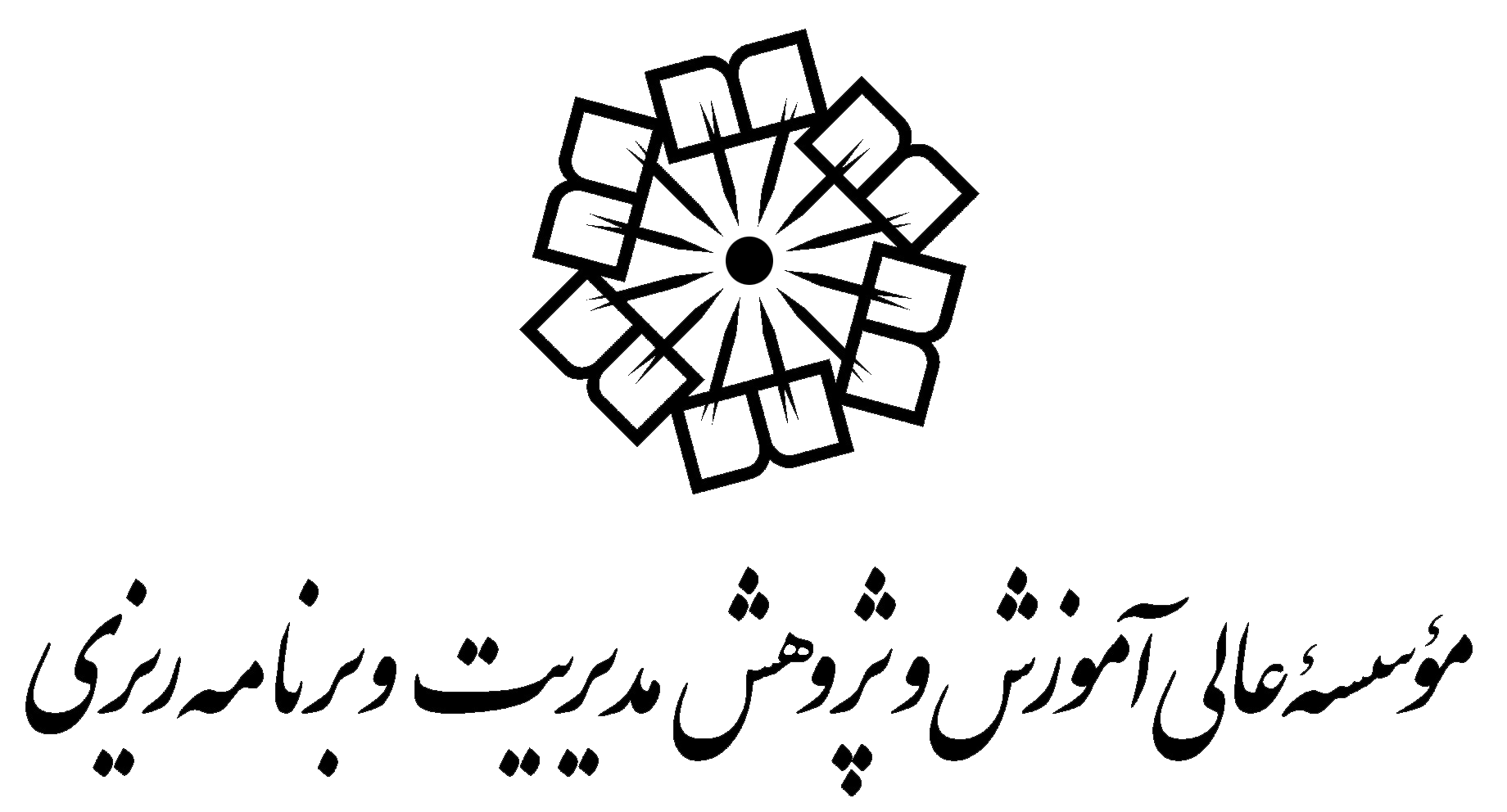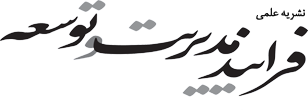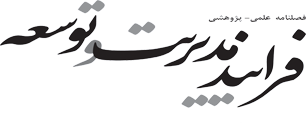1- گروه مدیریت، واحد میانه،دانشگاه آزاد اسلامی،میانه،ایران. ، Davoud.Haghkhah@gmail.com
2- گروه مدیریت، واحد میانه، دانشگاه آزاد اسلامی، میانه، ایران.
2- گروه مدیریت، واحد میانه، دانشگاه آزاد اسلامی، میانه، ایران.
چکیده: (337 مشاهده)
هدف: این پژوهش، با هدفِ بررسی مدلِ تأثیرِ رهبری اخلاقی ادراک شده، بر ترکِ خدمتِ کارکنان، با در نظر گرفتنِ نقشِ تعدیلگر اینرسی سازمانی، و نقشِ میانجیگرِ قانونشکنی خیرخواهانه، در سازمانهای دولتی، انجام شده است.
روششناسی: این پژوهش، توصیفی-پیمایشی، بر روی 291 نفر از کارکنانِ یک سازمانِ دولتی، در تبریز، که به روشِ نمونهگیری تصادفی ساده، انتخاب شدند، انجام شد. برای آزمودنِ الگوی پیشنهادی پژوهش، از روشِ الگویابی معادلاتِ ساختاری، استفاده شد. روشِ پژوهشِ حاضر، همبستگی و از نوعِ مدلسازی معادلاتِ ساختاری، است.
یافتهها: نتایج، نشان داد که رهبری اخلاقی، تأثیرِ منفی، و معناداری، بر ترکِ خدمتِ کارکنان، دارد. علاوه بر این، قانونشکنی خیرخواهانه، نقشِ میانجیگر، در این رابطه، ایفا میکند، در حالی که اینرسی سازمانی، اثرِ رهبری اخلاقی، بر ترکِ خدمتِ کارکنان را، تعدیل میکند.
اصالت/ارزش: این پژوهش، با ارائه شواهدِ تجربی، در موردِ روابطِ پیچیده، بینِ رهبری اخلاقی، ترکِ خدمت کارکنان، اینرسی سازمانی، و قانونشکنی خیرخواهانه، در زمینه سازمانهای دولتی، به ادبیاتِ موجود، کمک میکند. یافتهها، بینشهای ارزشمندی را، برای مدیرانی ارائه میدهد که به دنبالِ کاهشِ ترکِ خدمتِ کارکنان، و ایجادِ فضای سازمانی مثبت، هستند.
پیشنهادات : به سازمانهای دولتی، پیشنهاد میشود که شیوههای رهبری اخلاقی را، ترویج کنند، اینرسی سازمانی را، به طورِ مؤثر، مدیریت، و محیطی حمایتی، ایجاد کنند که قانونشکنی خیرخواهانه را، تشویق کند. این استراتژیها، میتواند به بهبودِ حفظِ کارکنان، و ارتقای عملکردِ سازمانی، کمک کند.
روششناسی: این پژوهش، توصیفی-پیمایشی، بر روی 291 نفر از کارکنانِ یک سازمانِ دولتی، در تبریز، که به روشِ نمونهگیری تصادفی ساده، انتخاب شدند، انجام شد. برای آزمودنِ الگوی پیشنهادی پژوهش، از روشِ الگویابی معادلاتِ ساختاری، استفاده شد. روشِ پژوهشِ حاضر، همبستگی و از نوعِ مدلسازی معادلاتِ ساختاری، است.
یافتهها: نتایج، نشان داد که رهبری اخلاقی، تأثیرِ منفی، و معناداری، بر ترکِ خدمتِ کارکنان، دارد. علاوه بر این، قانونشکنی خیرخواهانه، نقشِ میانجیگر، در این رابطه، ایفا میکند، در حالی که اینرسی سازمانی، اثرِ رهبری اخلاقی، بر ترکِ خدمتِ کارکنان را، تعدیل میکند.
اصالت/ارزش: این پژوهش، با ارائه شواهدِ تجربی، در موردِ روابطِ پیچیده، بینِ رهبری اخلاقی، ترکِ خدمت کارکنان، اینرسی سازمانی، و قانونشکنی خیرخواهانه، در زمینه سازمانهای دولتی، به ادبیاتِ موجود، کمک میکند. یافتهها، بینشهای ارزشمندی را، برای مدیرانی ارائه میدهد که به دنبالِ کاهشِ ترکِ خدمتِ کارکنان، و ایجادِ فضای سازمانی مثبت، هستند.
پیشنهادات : به سازمانهای دولتی، پیشنهاد میشود که شیوههای رهبری اخلاقی را، ترویج کنند، اینرسی سازمانی را، به طورِ مؤثر، مدیریت، و محیطی حمایتی، ایجاد کنند که قانونشکنی خیرخواهانه را، تشویق کند. این استراتژیها، میتواند به بهبودِ حفظِ کارکنان، و ارتقای عملکردِ سازمانی، کمک کند.
واژههای کلیدی: رهبری اخلاقی، ترک خدمت کارکنان، اینرسی سازمانی، قانونشکنی خیرخواهانه، سازمانهای دولتی.
فهرست منابع
1. Akpolat, T. (2023). Perception of Organizational Uncertainty as a Predictor of Teacher Inertia. International Journal of Psychology and Educational Studies, 10(1), 159-173. [DOI:10.52380/ijpes.2023.10.1.928]
2. Al Halbusi, H., Ruiz‐Palomino, P., Linuesa‐Langreo, J., & Scalzo, G. (2024). Ethical Leadership as a Driver of Supervisor Technical and Social Effectiveness: A Triple Helix for Cultivating Employees' Sense of Purpose. Business Ethics, the Environment and Responsibility. [DOI:10.1111/beer.12750]
3. Allen, D. G., Hancock, J. I., Vardaman, J. M., & McKee, D. N. (2010). Analytical mindsets in turnover research. Journal of Organizational Behavior, 31(2-3), 269-275.
4. Athanasiadou, C., Chatzoudes, D., & Theriou, G. (2023). Ethical Leadership and Turnover Intentions: A systematic literature review. IEEE Conference on Technologies for Sustainability, 41-48. [DOI:10.1109/SusTech57309.2023.10129599] [PMID] []
5. Bahrampour, Ramin, Sharifi, Mohammad, & Abedini, Tahereh. (2021). The impact of organizational inertia on employee motivation and satisfaction. Journal of Management and Organization, 52(4), 74-85. (in Persian)
6. Banwo, A. O., Omache, H., & Ngonadi, J. C. (2024). Overview of Institutional-Organizational Inertia Nexus (pp. 175-196). Springer International Publishing. [DOI:10.1007/978-3-031-51175-2_8]
7. Belinskiy, A., & Olsen, C. (2024). Influence of perceived congruence in basic moral values on perceived level of ethical leadership: A Russophone organization case. F1000Research, 13, 1472. [DOI:10.12688/f1000research.153281.1]
8. Brown, M. E., Treviño, L. K., & Harrison, D. A. (2005). Ethical leadership: A social learning perspective for construct development and testing. Organizational Behavior and Human Decision Processes, 97(2), 117-134. [DOI:10.1016/j.obhdp.2005.03.002]
9. Clark, R., Anderson, D., & Baker, S. (2021). Organizational inertia and its impact on leadership and organizational change. Journal of Management Research, 15(4), 254-269.
10. Colquitt, J. A., Scott, B. A., Rodell, J. B., Long, D. M., Zapata, C. P., Conlon, D. E., & Wesson, M. J. (2013). Justice at the millennium, a decade later: A meta-analytic test of social exchange and affect-based perspectives. Journal of Applied Psychology, 98(2), 199-236. [DOI:10.1037/a0031757] [PMID]
11. Cosgrove, M. R., Williams, E. D., Linvill, J. S., Buzzetta, A., Ojeda-Hecht, E., & Konkel, A. (2023). "It gave everybody a voice": dissent expression through COVID-19 and the Great Resignation. The Review of Communication. [DOI:10.1080/15358593.2023.2248226]
12. Dahliana, D., & Caturiani, S. I. (2024). Literature analysis on the application of work ethics in improving organizational performance. Al-Kharaj: Journal of Economics, Finance, and Sharia Business, 6(11). [DOI:10.47467/alkharaj.v6i11.5712]
13. Fathi-Livari R, Hamidizadeh A, Sanoubar N, Zareei-Matin H. (2019). Designing and Validating the Ethical Leadership Model in Organizations. JMDP. 31(4), 37-62. (in Persian) [URL: http://jmdp.ir/article-1-3235-fa.html]
14. Habibi, R. (2019). The Impact of Perceived Moral Leadership Behavior on Citizenship Rights and Organizational Cynicism. Bioethics, 9(31), 9-20. [DOI:10.22037/BJ.V9I31.26986]
15. Halbusi, H. A., Williams, K. A., & Ramayah, T. (2024). The impact of ethical leadership on employees' sense of purpose and technical and social effectiveness. Journal of Business Ethics, 180(3), 567-582. [DOI:10.1007/s10551-023-05567-1]
16. Hannan, M. T., & Freeman, J. (1984). Structural inertia and organizational change. American Sociological Review, 49(2), 149-164. [DOI:10.2307/2095567]
17. Hassani, Mohammad, & Rostgar, Saeed. (2023). The role of ethical leadership in reducing employee turnover. Iranian Journal of Organizational Behavior, 15(1), 45-65. (in Persian)
18. Hernandez, L., Garcia, T., & Marquez, D. (2022). Organizational inertia and burnout: Impact on employee turnover. Journal of Industrial Psychology, 18(2), 124-136.
19. Hernita, N., Marianti, M. M., & Deti, R. (2024). Sebuah Tinjauan Literature Review: Intention To Leave. Coopetition : Jurnal Ilmiah Manajemen, 15(3), 419-442. [DOI:10.32670/coopetition.v15i3.4795]
20. Hom, P. W., Mitchell, T. R., Lee, T. W., & Griffeth, R. W. (2012). Reviewing employee turnover: Focusing on proximal withdrawal states and an expanded criterion. Psychological Bulletin, 138(5), 831-858. [DOI:10.1037/a0027983] [PMID]
21. Kanyamukenge, C., & Kagwaini, D. M. (2024). Role of Ethical Leadership in Promoting Sustainable Business Practices. International Journal of Business and Management, 19(6), 209. [DOI:10.5539/ijbm.v19n6p209]
22. Kaptanoglu, R. Ö. (2020). İşten Ayrılma Niyeti ve Toksik Liderliğin Etkisi. Journal of International Scientific Researches, 6, 161-173. [DOI:10.21733/IBAD.621500] [https://doi.org/10.21733/ibad.621500]
23. Karbasi, N. S., & Alavi, S. B. (2024). Unveiling the potential of perceived authentic leadership to enhance followers' moral intentions: a self-determination theory perspective. Management Research Review. [DOI:10.1108/mrr-05-2023-0318] [https://doi.org/10.1108/MRR-05-2023-0318]
24. Kim, S. H., Lee, J. H., & Lee, K. H. (2020). Organizational inertia and its effect on employee turnover: The moderating role of ethical leadership. Journal of Business Ethics, 169(3), 453-471.
25. Kim, T., & Lee, G. (2020). Structural inertia and innovation performance in organizations: Mediating effects of organizational learning. Technological Forecasting and Social Change, 151, 119827.
26. Lee, J., Kim, S., & Park, H. (2025). Ethical leadership and organizational citizenship behavior: The mediating role of trust and job satisfaction. Journal of Business Ethics, 190(3), 567-582. [DOI:10.1007/s10551-025-06789-1]
27. Majeed, N., Jamshed, S., & Mustamil, N. (2018). Striving To Restrain Employee Turnover Intention Through Ethical Leadership And Pro-Social Rule Breaking. 2(1), 39-53. [DOI:10.22452/IOJEL.VOL2NO1.4] [https://doi.org/10.22452/iojel.vol2no1.4]
28. Miller, D. (1993). The architecture of simplicity. Academy of Management Review, 18(1), 116-138. [DOI:10.2307/258825]
29. Miri B, Ghorbanizadeh V, Seyed Naghavi M. (2021). Phenomenological Analysis of Employees' Turnover Experience in a Public Organization. JMDP. 34(3), 113-142.(in Persian) [DOI:10.52547/jmdp.34.3.113] [doi:10.52547/jmdp.34.3.113]
30. Mobley, W. H. (1977). Intermediate linkages in the relationship between job satisfaction and employee turnover. Journal of Applied Psychology, 62(2), 237-240. [DOI:10.1037/0021-9010.62.2.237]
31. Mosavi, Fatemeh, & Heydari, Kazem. (2022). The effect of benevolent rule-breaking on employees' organizational commitment. Iranian Journal of Human Resource Management, 8(3), 123-145. (in Persian)
32. Mosavi, Samaneh, & Heydari, Jalal. (2022). The role of benevolent rule-breaking in increasing organizational commitment and reducing turnover intention. Journal of Social Psychology, 43(2), 67-82. (in Persian)
33. Morrison, E. W. (2006). Doing the job well: An investigation of pro-social rule breaking. Journal of Management, 32(1), 5-28. [DOI:10.1177/0149206305277790]
34. Naseri, Saeed, Amiri, Hamid, & Hosseini, Fatemeh. (2022). Benevolent rule-breaking as a mediator in the relationship between ethical leadership and turnover intention. Journal of Organizational Psychology, 30(2), 23-36. (in Persian)
35. Nazeripour, Mohammad, Ahmadi, Hassan, & Kiani, Mohammad. (2020). The impact of ethical leadership style on increasing employee trust and performing informal duties. Journal of Organizational Behavior, 25(1), 42-56. (in Persian)
36. Neubert, M. J., Carlson, D. S., Kacmar, K. M., Roberts, J. A., & Chonko, L. B. (2009). The virtuous influence of ethical leadership behavior: Evidence from the field. Journal of Business Ethics, 90(2), 157-170. [DOI:10.1007/s10551-009-0037-9]
37. Noroozi, M., Parchami, M., Beyhaghi, S., Armin, S., Goodarzi, S., Takács, E., & Abcouwer, T. (2024). Navigating Resistance to Technological Change in Organizations: A Holistic Approach. [DOI:10.34190/ecmlg.20.1.3175]
38. Ofem, O. (2024). Ethical Integration of AI into Organizational Behavior: Introducing the AI-IOB Model. [DOI:10.21203/rs.3.rs-5272515/v1]
39. Panahi, Shahab, & Moeini, Mohammad. (2021). Organizational inertia and its effect on leadership effectiveness in organizations. Iranian Journal of Human Resource Management, 24(3), 150-165. (in Persian)
40. Saleem, A., Bhutta, M. K. S., Abrar, M., Bari, M. W., & Bashir, M. (2024). Leader's ethical behavior: A precursor to employees' well-being through emotions management. Acta Psychologica, 249, 104453. [DOI:10.1016/j.actpsy.2024.104453] [PMID]
41. Şen, H., Erbil, C., & Aydoğan, E. (2019). Etik Liderliğin İşten Ayrılma Niyetine Etkisinde Algılanan Kurumsal İtibarın Rolü (The Role of Perceived Corporate Reputation on the Impact of Ethical Leadership to Turnover Intention). Journal of Business Research-Turk, 11(2), 876-889. [DOI:10.20491/ISARDER.2019.642] [https://doi.org/10.20491/isarder.2019.642]
42. Sharifian, P. (2024). Intention to Leave the Service in Nurses During the COVID-19 Pandemic: A Systematic Review. [DOI:10.18502/tkj.v16i2.16092]
43. Shore, L. M., Bommer, W. H., & Tetrick, L. E. (2021). The role of perceived organizational support in reducing employee turnover intentions. Journal of Organizational Behavior, 42(5), 621-637. [DOI:10.1002/job.2521]
44. Smith, A., & Johnson, B. (2025). The impact of ethical leadership on organizational conflict and employee satisfaction. Journal of Management Studies, 62(4), 789-805. [DOI:10.1111/joms.13045]
45. Tang, G., Yu, B., Cooke, F. L., & Chen, Y. (2020). High-performance work systems and employee pro-social rule breaking: The roles of job crafting and trust in management. Human Resource Management Journal, 30(2), 256-272.
46. Teofilus, T., Ardyan, E., Sutrisno, T. F. C. W., Sabar, S., & Sutanto, V. (2022). Managing Organizational Inertia: Indonesian Family Business Perspective. Frontiers in Psychology, 13. [DOI:10.3389/fpsyg.2022.839266] [PMID] []
47. Treviño, L. K., Harrison, A., & Freeman, J. (2022). Ethical leadership and its impact on creativity and prosocial rule-breaking behaviors in organizations. Journal of Ethical Leadership, 10(3), 32-45.
48. Van Quaquebeke, N., Becker, J. U., Goretzki, N., & Barrot, C. (2019). Perceived Ethical Leadership Affects Customer Purchasing Intentions Beyond Ethical Marketing in Advertising Due to Moral Identity Self-Congruence Concerns. Journal of Business Ethics, 156(2), 357-376. [DOI:10.1007/S10551-017-3577-4] [https://doi.org/10.1007/s10551-017-3577-4]
49. Walumbwa, F. O., Mayer, D. M., Wang, P., Wang, H., Workman, K., & Christensen, A. L. (2011). Linking ethical leadership to employee performance: The roles of leader-member exchange, self-efficacy, and organizational identification. Organizational Behavior and Human Decision Processes, 115(2), 204-213. [DOI:10.1016/j.obhdp.2010.11.002]
50. Warren, D. E. (2003). Constructive and destructive deviance in organizations. Academy of Management Review, 28(4), 622-632. [DOI:10.5465/amr.2003.10899440] [https://doi.org/10.2307/30040751]
51. Xu, A. J., Loi, R., & Lam, L. W. (2021). Ethical leadership and its implications for workplace outcomes: A multi-level analysis. Asia Pacific Journal of Management, 38(2), 349-375.
52. Yen, Y., & Wang, H. (2023). Ethical Leadership and Employee Turnover Intention: Exploring Multiple Mediation Mechanisms. Proceedings - Academy of Management, 2023(1). [DOI:10.5465/amproc.2023.13802abstract] [https://doi.org/10.5465/AMPROC.2023.13802abstract]
53. Zhang, J., Chiu, R. K., & Wei, L. Q. (2018). Pro-social rule breaking in the workplace: Taking a social exchange perspective. Journal of Business Ethics, 149(4), 1089-1103.
54. Zhang, Y., Zheng, X., & Zhao, X. (2021). Benevolent whistleblowing and its influence on employee commitment and turnover intentions. Journal of Business Research, 129, 512-521.
55. Zhou, X., Ma, J., & Cheng, W. (2015). The impact of ethical leadership on organizational conflict and cohesion: Evidence from Chinese enterprises. Journal of Business Ethics, 132(4), 853-864. [DOI:10.1007/s10551-014-2332-3]
| بازنشر اطلاعات | |
 |
این مقاله تحت شرایط Creative Commons Attribution 4.0 International License قابل بازنشر است. |






